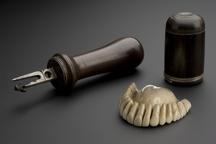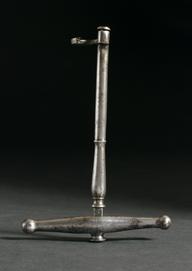


Dental key embellished shaft with single bend. Single claw position, silver mounted with ivory handle. Probably made in France circa 1800-1840.
Dental keys or tooth keys were introduced in the early 1700s and became the instrument of choice for tooth pulling from the 1770s onwards.
The claw was placed over the top of the tooth and the bolster, the long metal rod to which the claw is attached, was placed against the root of the tooth. This example has a single bend in the shaft, an alteration that was introduced around 1780 by Joseph Leber (1727-1808) to prevent pressure being applied to the adjacent teeth. The key was then turned as if the user were opening a lock and the tooth would hopefully be removed. Undoubtedly this operation was extremely painful for the patient who most likely had to be restrained. This example is made of silver, has an ivory handle and was probably made in France.
Details
- Category:
- Dentistry
- Collection:
- Sir Henry Wellcome's Museum Collection
- Object Number:
- A616561
- Measurements:
-
overall: 26 mm x 150 mm x 93 mm, 0.1kg
- type:
- dental key



